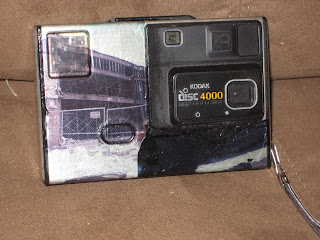
This camera was in pretty admirable shape, and when I did some test winds and tripped the shutter a few times, it sounded as smooth as a new camera. I was pretty impressed at its condition. The leather case has definitely seen some action, wearing around the back flaps where it snaps onto the body is evident. It's pretty clear someone enjoyed this camera, both by its working condition (with little to know cosmetic damage) and by its case's wear. I'm kinda happy to give it a new home.
I noticed some quirks with the camera right off the bat when I opened the cover. First, the focusing ring seemed to be a slight bit tight. I can turn it fine, it just is somewhat sluggish. Upon testing of the camera itself, while somewhat tight for twisting the focusing ring, the focus is nice and tight. I was sort of worried about it at first, but now I'm fairly confident that I'll be able to live with a focusing ring that is a little stiff.
The second thing I noticed is that the film advance lever is quite the opposite to focusing ring. It's sort of strange how that works, isn't it? The film advance lever is nice and smooth, but honestly will take a little getting used to, as so little effort is needed to advance the film. Again, in the grande scheme of things, for a camera that's going on fifty years old now, this little camera handles like a dream.
The third quirk I noticed is the camera's controls. I'm somewhat at a loss to exactly know what to call it. I mean, the camera has settings based off of the EV (Exposure Value) rather than the aperture and shutter speed. I'm somewhat at a loss as to what to call it. Semi-Automatic? Quasi-manual? Sure, I set the EV, but I don't really mess with the aperture and shutter speed. I can set the EV above or below what it says, hence over or underexposing the frame... I'm somewhat at a loss right now. Either way, it works absolutely fine in normal sunlight - the negs were right around as dense as my shots normally are when I shot in direct sunlight. Where I found the problem is when I was taking pictures in relative shade. It was around a EV of around 10 when I noticed the negs getting thinner and thinner. From what little research I've done regarding Selenium Light Meters (I also found a Canon/Bell & Howell Canonet) have taught me that the Selenium light meter tends to trail off in the terms of accuracy the less and less light there is. Again, it can be worked around fairly easily.
I've done one test roll of film. Aside from what I've just talked about, I've also noticed some more indications for this camera. The Rokkor (I can't get enough of that lens maker's name... I'm such a nerd...) 45mm f/2.8 is remarkably crisp. Some of the pictures were taken off of my balcony, and the power lines across the street were both visible and rather crisp. The meter is incredibly accurate when it comes to brightly lit scenes - there's little if any variation. The Selenium cell's placement is slightly off putting, as is the dial showing the EV, but this will simply take some getting accustomed to this camera. The Parallax Correction is pretty spot-on, and the only time it really becomes a problem is when I'm around 3-4 feet from the subject. I'm working on a second test roll where I'm trying to stem the thin negative in soft and subdued light problem. I'll post when I get that one done, but as it stands now, I'm pretty happy with my new old camera.





















